In our previous article, we’ve shown you how to setup prerequisites for Oracle 12c installation. In this article we will cover installation and configuration of Oracle 12c in RHEL/CentOS/Oracle Linux 6.5, along with some Oracle post installation instructions.
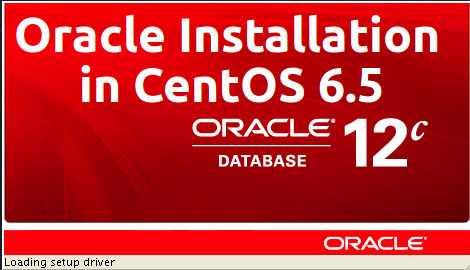
Requirements
Installing Oracle 12c Database in CentOS 6.5
1. After extracting, we will get database directory which has 2.6GB in size. So, next we can go-head and install the oracle. Let us start the installation by running runInstaller. Navigate the installer Directory and run the Installer.
# cd database/ # ./runInstaller
Our Installer has been launched here. For every steps we need to move forward by Clicking Next or OK.

Configure Security Updates
2. I’m going to skip this step as I don’t want security updates. Un-check the check box and mark the checkbox that says “Wish to receive security updates via My Oracle Support“.
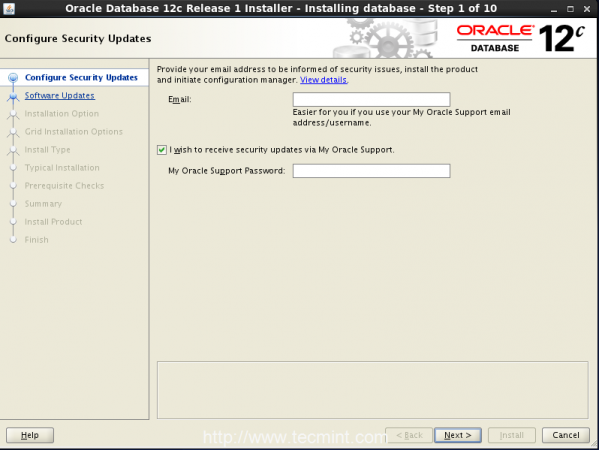
Click on Next, you will get a error saying that you’ve not provided and email address click Yes to continue.

Software Updates
3. While we skiped the email step by default it will choose skip software updates Click next to continue.
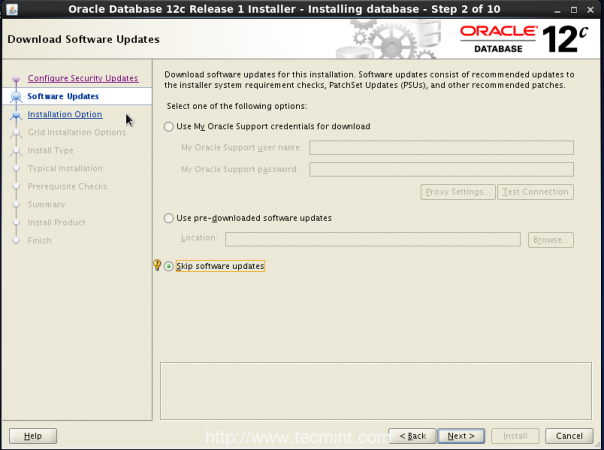
Here I have resolved every dependencies but still it says that I have not reached the minimum requirements. Don’t worry, you can move forward to choose Yes to continue.

Installation Option
4. Next, choose the type of installation, I’m choosing the first option to Create and configure a database.

System Class
5. I’m going to choose Server Class here. If we need to install in any Desktop machines we can choose the above Option as Desktop Class.

Grid Installation Options
6. We are going to setup only single instance database installation here. So, select the first option.
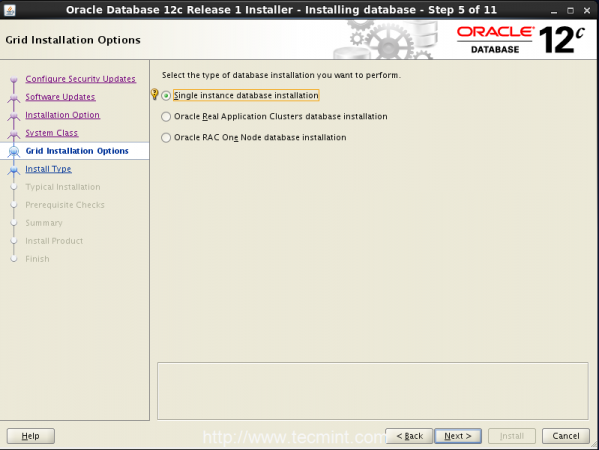
Install Type
7. Choose the Advance install option to get more option while going through Installation steps.

Product Languages
8. By Default Language will be chooses as English. If you need to change according to your language, choose from the below list.

Database Edition
9. Time to choose which edition of database installation we looking for. For large scale Productions we can use Enterprise or if we need standard edition or we can choose the options as mentioned there. We need more than 6.5 GB space for Enterprise installation because database Population will grow soon/increase.

Installation Location
10. Enter the Oracle base installation location, here all installed configurations files will be stored. Here you need to define the location of oracle installation path, as we created the location in step #12 in the first part of this article.

Creating Inventory
11. For the first time installation, every Inventory files will be created under ‘/u01/app/oralnventory‘ directory. We have created the group oracle for installation. So now the oracle group has permission to access Inventory Directory. Let us choose the Oracle as the Group for Operating system group.

Configuration Type
12. Select the type of database, you want to create. Since, we are using for General purpose, so choosing general from the below options and click Next.
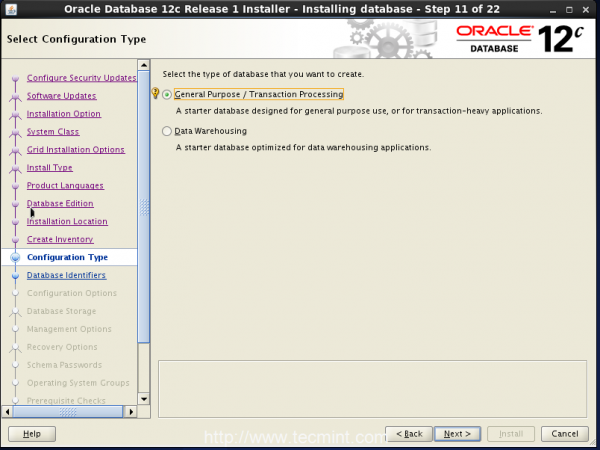
Database identifiers
13. Specify the Global Database name for uniquely identified and un-check the Create as Container database, as here we are not going to create multiple databases.
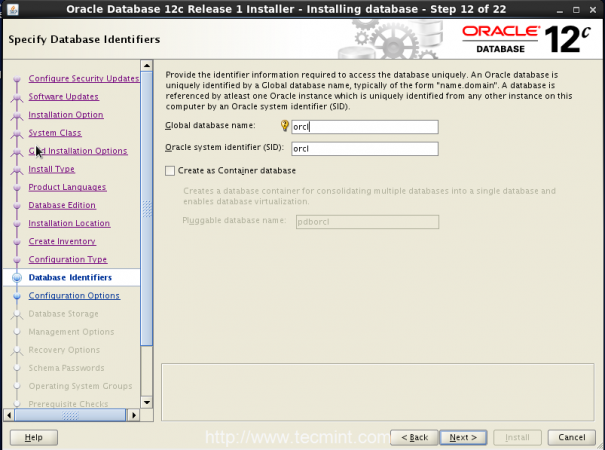
Configuration Options
14. In my installation, I have assigned 4GB of Memory to my virtual machine, but this is not enough for Oracle. Here we need to Enable allocate memory automatically for the use of system global Area.
Check the box that says Enable Automatic Memory Management and keep the default allocate memory. If we need some sample schema’s we can check and continue for installation.
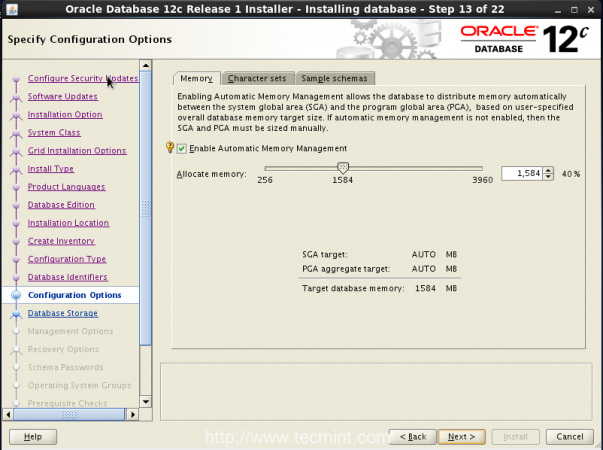
Database Storage
15. We need to choose the location to store the database storage. Here I’m going to assign ‘/u01/app/oracle/oradata‘ location to save the databases and Click Next to continue to installer steps.

Management Options
16. I don’t have a Cloud control manager credentials from oracle, so I have to skip this step.
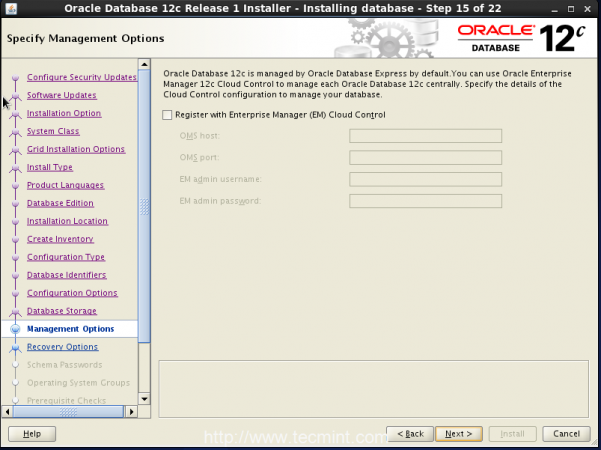
Recovery Options
17. If we have to Enable recovery options, then we have to check the Enable Recovery. In real environment these options are Compulsory to setup. Here to enable this option we need to add separate group and we need to define one of the file system location rather than default location where our database save.
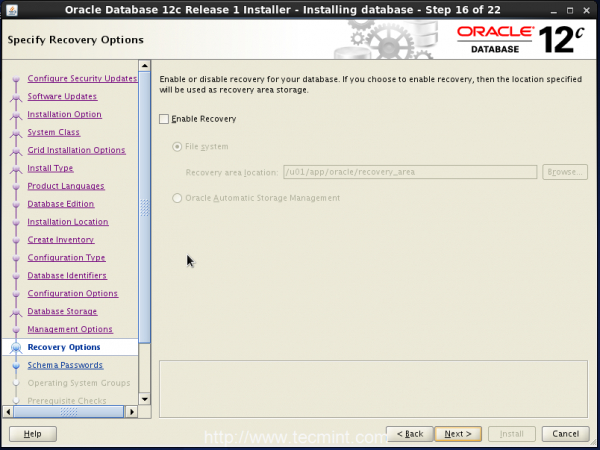
Schema Passwords
18. We need to define the password for starter database which is all pre-loaded while the installations. Password must contain alphanumeric, upper_case and lower_case. For example, my password is Redhat123. This password we will use in web interface login too.
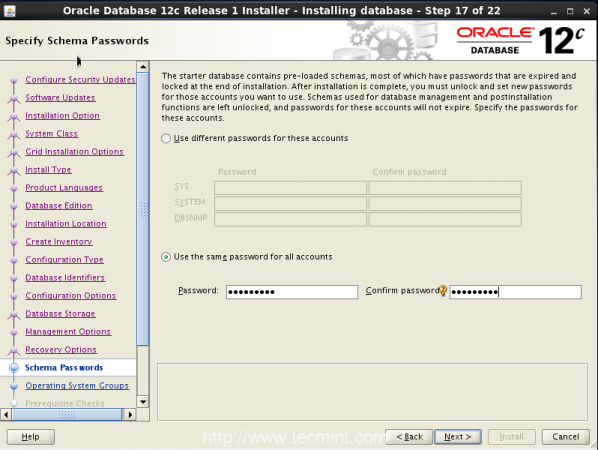
Operating system Groups
19. We need to provide system privileges to create database for that we need to choose the oracle group. Choose oracle for every options.
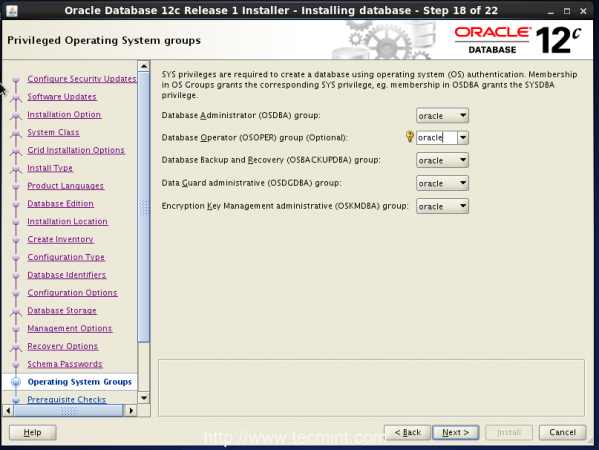
Summary
20. At last we can review every settings before database population. If we need any changes we can edit the settings.

Install Product
21. Installation started to Preparation and copying files. This will take long time to complete according to our Hardware Resource.

22. During setup process, it will ask to run two scripts as a root user as shown in the below picture.
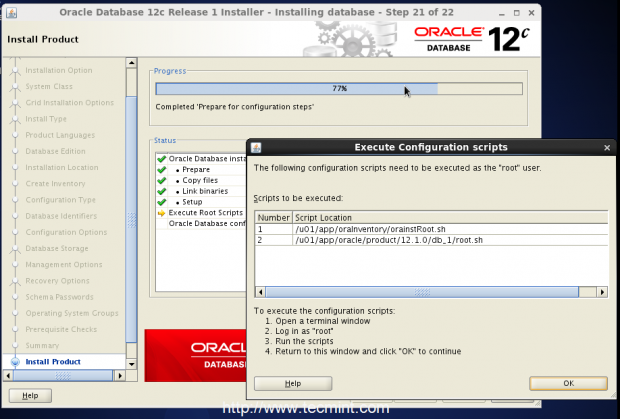
Login into your Oracle Server as root user and switch to ‘/‘ partition and execute below scripts as shown.
# cd / # ./u01/app/oralnventory/orainstRoot.sh # ./u01/app/oracle/product/12.1.0/db_1/root.sh
During the script execution process, might it will ask you to enter the full path-name of the local bin directory, just enter the path as shown below and press Enter.
/usr/bin
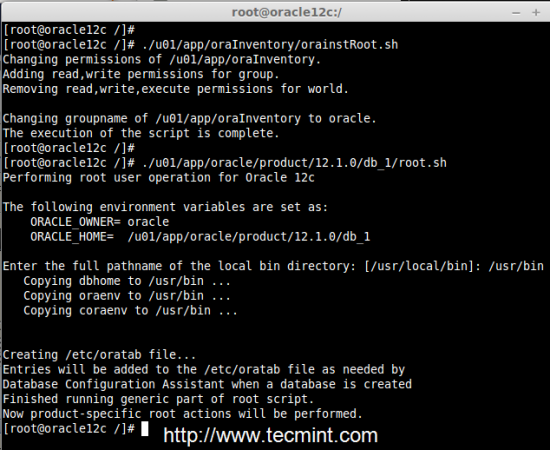
23. After successfully execution of above two scripts, we need to move forward by clicking on OK.
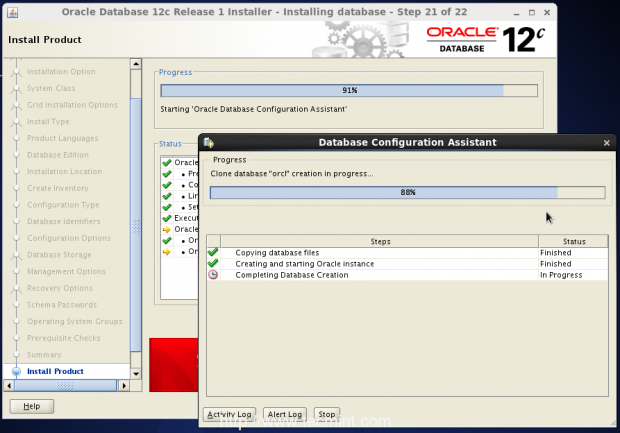
24. After finishing all the above tasks successfully, we will receive the Database Configuration Assistant window with the all the details and it will show you the EM Database Express URL. Click OK to move forward.
https://oracle12c.tecmint.local:5500/em

If you wish to change the database accounts password, you can use the password management.

That’s it! We’ve successfully completed Database Configuration, now click Next to continue installation process.
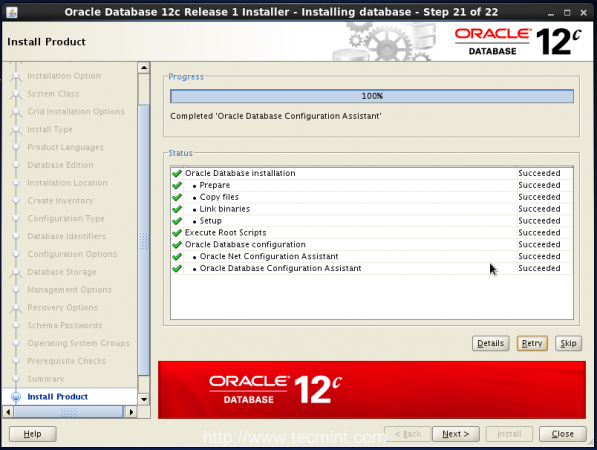
Finally Oracle Database installation was successfully completed. Click on Close to quit the Oracle Installer.
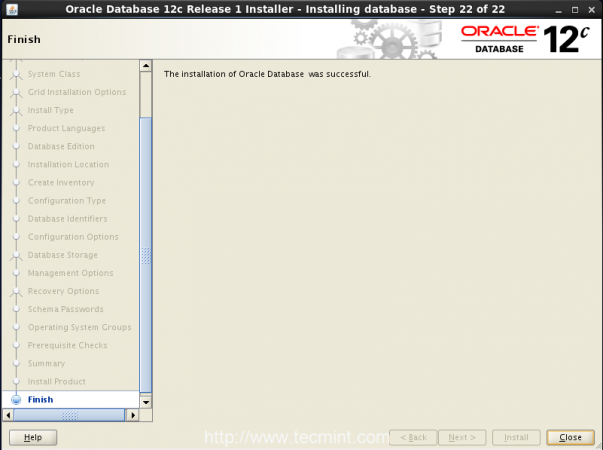
25. After completing the Database installation, now move ahead to do some Post installation configuration. Open file ‘oratab‘ using vi editor.
# vim /etc/oratab
After opening file, search for the the following line.
orcl:/u01/app/oracle/product/12.1.0/db_1:N
And change the parameter N to Y as shown.
orcl:/u01/app/oracle/product/12.1.0/db_1:Y
Restart the machine to take new changes.
26. After restarting machine, verify that the listener is up and running using ‘lsnrctl status‘ command.
# lsnrctl status

If it does not start automatically, you will need to start it manually using ‘lsnrctl start‘ command.
# lsnrctl start
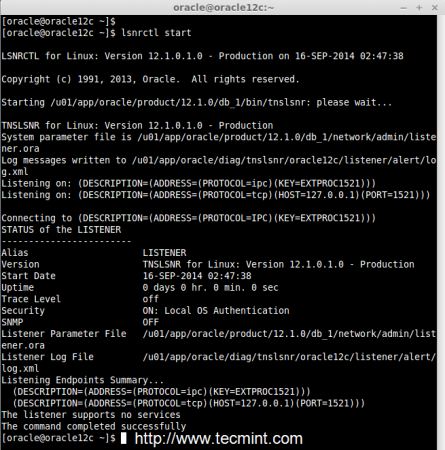
Note: If the lsnrctl does not start, read the troubleshooting step (mentioned at the end of the article) to get fix the errors if any and try to start the listener.
27. Next login into Oracle database as a Operating system user using sysdba and start-up the database.
# sqlplus / as sysdba # startup

28. Now it’s time to access Oracle Web interface at the following addresses.
https://oracle12.tecmint.local:5500/em OR https://192.168.0.100:5500/em
When EM Express prompts you for your username and password, Use to log in as a user with DBA privilege such as SYS or SYSTEM and use the password which we used for Schema password.
Login User = SYSTEM Password = Redhat123

29. After login into the Oracle panel, you can see the main interface as Database Home and few screen shot as shown below.
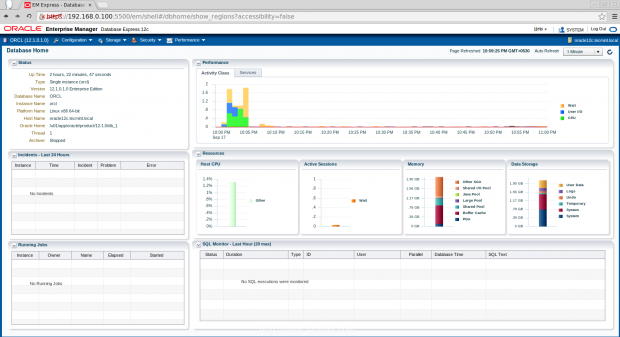



Step: Troubleshooting Oracle
30. If listener does not start, you need to replace the domain name with local IP address 127.0.0.1 in below file.
/u01/app/oracle/product/12.1.0/db_1/network/admin/listener.ora

That’s it! Finally we’ve successfully completed Oracle 12c installation and configuration in CentOS 6.5. If in-case any errors you get while setting up Oracle database 12c, feel free to drop your comments.



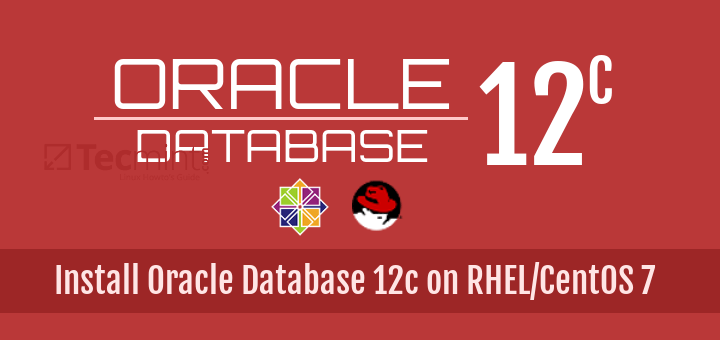
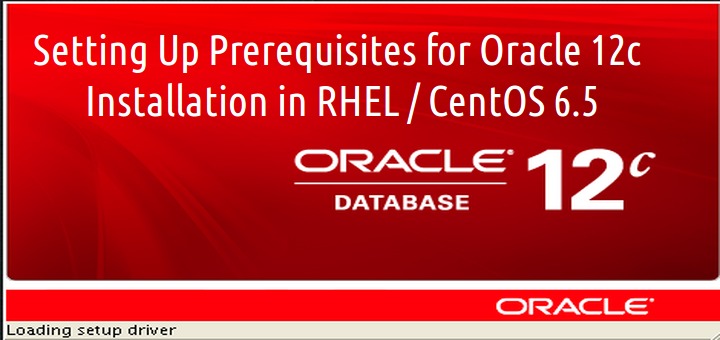
I was facing following error,
“Error in invoking target ‘irman ioracle’ of makefile ‘/u01/app/oracle/product/12.1.0/db_1/rdbms/lib/ins_rdbms.mk’ “
I resolved this by copying libjavavm12.a to $ORACLE_HOME/llib directory.
# cp /u01/app/oracle/product/12.1.0/db_1/javavm/jdk/jdk6/lib/libjavavm12.a /u01/app/oracle/product/12.1.0/db_1/lib/Hope this will help someone.
@Chetan,
Thanks for sharing the tip, hope it will help other users who face similar issue while installing Oracle in CentOS.
The only tutorial helped me.
Thanks a lot!
Hello, I want to install oracle db 12c in active passive mode without grid is possible to in RHEL HA
Hello,
when I reboot the server I have to start the listner and DB manually, how we can start it automatically on boot !
@nla,
Only possible we need to add the entry in oratab, init script. You can refer below URL for the same.
https://oracle-base.com/articles/linux/automating-database-startup-and-shutdown-on-linux
Regards,
I resolved the problem, in centos7 you have to create a script to start the listner and DB at the boot..
this is the script :
@nla,
Awesome, Thanks for your startup script hope upcoming readers get a notice on it.
Regards,
before running ./runInstaller you need to do xhost + from root user
If you logged in as Oracle user, then there is no need to run xhost + command, This is required when you login through root user and then switch the role to oracle user.
Hi Babin,
After successful installation of 12c I am not able to access em. Can you suggest how to troubleshoot it..
Best Regards,
Nagaraju
@Nagaraju,
1. Please look into listener.ora host entry, Please add the host entry in the /etc/hosts if you don’t have a valid DNS server.
2. If you have a valid DNS server please check the DNS address under /etc/resolv.conf.
3. Check your iptables add a rule for web interface or flush it ( iptables -F), Check the lsnrctl status.
Just completed installation of 12c on Oracle linux 7. This webpage (both part1 and part2) is authentic and error free as far as my needs are concerned.
@Swathyprabhu,
Thanks for the feedback, Hope all the required dependencies are resolved for 12C installation in OEL7.
Hi Babin,
I have successfuly installed Oracle 12c as per your installation guide. Thank you very much .
Thanks,
Suresh
hi sir,
i followed ur steps ,i try this step to resolve listener (If listener does not start, you need to replace the domain name with local IP address 127.0.0.1 in below file.) its worked
i tyed this but its not working
28. Now it’s time to access Oracle Web interface at the following addresses.
https://oracle12c.localdomain:5500/em –this my url i gotted while installation
OR
https://192.168.119.131:5500/em
i am getting this error
Unable to connect
Firefox can’t establish a connection to the server at oracle12c.localdomain:5500.
this my host file
[oracle@oracle12c ~]$ cat /etc/hosts
127.0.0.1 localhost localhost.localdomain localhost4 localhost4.localdomain4
192.168.119.131 oracle12c oracle12c.localdomain
[oracle@oracle12c ~]$
and also i am getting while i logging to sqlplus / as sysdba
[oracle@oracle12c ~]$ sqlplus / as sysdba
SQL*Plus: Release 12.1.0.2.0 Production on Wed May 18 19:27:05 2016
Copyright (c) 1982, 2014, Oracle. All rights reserved.
Connected to an idle instance.— see this i gott this error means it is not connected to database so please give me solution
SQL> select dbms_xdb_config.gethttpsport() from dual;
select dbms_xdb_config.gethttpsport() from dual
*
ERROR at line 1:
ORA-01034: ORACLE not available
Process ID: 0
Session ID: 0 Serial number: 0
give me solution
@balakrishna,
Have you installed oracle in your local machine? Or in virtual box, vmware ?
If you installed oracle in vb please add host entry under /etc/hosts, same we need those vb ip under base OS host entry.
Here your issue is domain name not resolving that’s it.
Regards
Hi All,
I was able to run this “sqlplus / as sysdba” with success. But when I tried to run “startup”, I got this message,
“ORA-01078: failure in processing system parameters
LRM-00109: could not open parameter file ‘/home/u01/app/oracle/product/12.1.0.2/db_1/dbs/initcdb1.ora'”
Can someone help me? I have installed Oracle 12C on fedora 23
@Andre,
Look like parameter file missing please run a find command as follows.
find /home/u01/app/oracle/product/12.1.0.2/ -name *.ora -type f
Hi babin.
Thanks for wonderful tutorial.
My only problem is accessing it’s web interface.. I can’t go in there when I tried: http://oracle_12C.localdomain:1539/em firefox says :Unable to connect
In my linux terminal is all ok:
[oracle@localhost ~]$ startup
[oracle@localhost ~]$ sqlplus / as sysdba
SQL*Plus: Release 12.1.0.2.0 Production on Mon Apr 11 20:28:06 2016
Copyright (c) 1982, 2014, Oracle. All rights reserved.
Connected to an idle instance.
SQL> startup
ORACLE instance started.
Total System Global Area 792723456 bytes
Fixed Size 2929400 bytes
Variable Size 583011592 bytes
Database Buffers 201326592 bytes
Redo Buffers 5455872 bytes
Database mounted.
Database opened.
Please help
@elem,
Can you try to disable iptables and try again to access from web.
iptables -F
service iptables stop
Never run iptables -L once it stopped.
Hi team,
I got below below error message after installing oracle 12c
lsnrctl status
-bash: lsnrctl: command not found
Kindly quide me.
Thanks,
Senthil.
@Senthil,
Please provide us logs kindly look into logs it will help to resolve the issue.
Hi babin,
I am getting the below error while i run
lsnrctl start as ‘oracle’ user
Message 1053 not found; No message file for product=network, facility=TNSTNS-12541: Message 12541 not found; No message file for product=network, facility=TNS
TNS-12560: Message 12560 not found; No message file for product=network, facility=TNS
TNS-00511: Message 511 not found; No message file for product=network, facility=TNS
Linux Error: 111: Connection refused
Can you please help with this?
i tried changiinig hostname in listener.ora as well,it did not work either.
@Subin Alex,
Can you please provide the logs it will help us to point the exact issue.
Hi ,
This post was very useful.
Regards,
Alex
Please how do you install the Oracle Management pack, I see you have the extra performance tab enabled in EM
@Saul,
It includes in Oracle 12C Enterprise edition full installation.
hi, i was strucked in a question, when i installed oracle12c in database configureation stage. my OS is rhel7. I get a error “The EM Express port “”is not valid. Specify a valid unused port “. there is no port. then, i clicked ok button and continued with install, and get message at the end of install. then, i , as root, run the command sqlplus / as sysdba, and startup the database. i get another error, the screenshot was in below. i lookup the folder in ‘/u01/app/oracle/product/12.1.0/db_1/dbs/’, there is nothing besides a file named init.ora. please help me to solve it.
ORA-01078: failure in processing system parameters
LRM-00109: could not open parameter file ‘/u01/app/oracle/product/12.1.0/db_1/dbs/initorcl.ora
@LP
This instruction works fine in Centos 6.x series, Centos 7 have some dependencies resolve issue
I also have the same problem and I’m using Cento 6.8. Did you manage ti find the solution perhaps?
Thanks, Dragan
As per steps, I have installed Oracle db12c on RHEL6.5 , everything is working fine. I have started listner, started DB as well using #sqlplus / as sysdba
#startup.
done netstat -an |grep 80 , 443, 5500 which is em port. all are listing state but still I am not able to access db from console.
Need help to resolve this issue ASAP.
Very nicely documented. I have posted some installation guides on other platforms Solaris) including Database and RAC software installations at http://www.vitalsofttech.com/oracle-12c-database-installation-on-solaris-11/ .
HI,
While runing the script orainstroo.sh gives the below error. Iam running as a root user, can you pls help me in resolving the issue
/bin/cp: not writing through dangling symlink `/etc/oraInst.loc’
/bin/chmod: cannot operate on dangling symlink `/etc/oraInst.loc’
when I reach Oracle Database Configuration Assitans I get ORA-12547 TNS Lost contact I tried everything two times with Linux Centos 7.
This installation steps are only works for Centos 6.
I have installed the db oracle and made changes to the file listener.ora but when i try to connect to web interface, i ‘m not able to connect!
Can you help me?
@Mario Principato
If listener does not start, you need to replace the domain name with local IP address 127.0.0.1 in below file.
/u01/app/oracle/product/12.1.0/db_1/network/admin/listener.ora
Only if you don’t have a local DNS server make changes to this file, oracle12c.tecmint.local to 127.0.0.1
Don’t forgot to restart the machine.
Then restart the listener by switching to Oracle user, //lsnrctl start //
Then check for status //lsnrctl status//
Next login into Oracle database as a Operating system user using sysdba and start-up the database.
# sqlplus / as sysdba
# startup
This will fix your issue.
I was trying to install 12c release 1 got install option at the end after around completion of 30-40% of installation i got error as /oracle/dbhome_01/____.sql file not found error can you help me….
Log please, While showing some error there will be log, Provide me the log paste your log in http://paste.ubuntu.com/ and give the URL
I’m using centos 7 and I cannot find the 90-nproc.conf file which uses to limit the file limit for all users. How can I configure those limits in centos 7
Above instructions only for Centos 6.x, Centos 7 installation steps are not compatible with this.
Nice post. Got me up and running quickly. Big thanks.
Excellent. I am from windows environment. This is well documented, installed and everything work perfectly.
Thanks,
Thanks for you feedback, Happy to hear from you.
@Berbard, Cool! Happy to hear that. Thanks for your precious reply.
Thank you.
I’ve installed it on Oracle Linux Server 7 following Part I & Part 2 of your (well done) tutorial. It works fine.
The only problem I got was connecting to https://oracle12.tecmint.local:5500/em
Navigator told me that the ‘certificate’ wasn’t a good one.
I’ve just told it to make an exception. (with chrome you need version 32, with the 31, I was stuck)
stop & disable firewalld
start & enable ssh.service
Regards.
I ‘ve forgotten to say that the install was made on a old Asus A8V Deluxe motherboard (2004) with 2 Gb ram and an AMD opteron 180 dual core as processor ;)